Lindell, Lyndeborough, Lamb, and Lockport
Several bottle manufacturing factories in the United States used the L. G. CO. mark, which has created confusion for bottle collectors and archaeologists trying to properly attribute specimens. Those factories include:
1) Lindell Glass Company, St. Louis, Missouri (1874- 1891), the mark is most commonly seen on the base of “export style” beer bottles, but also on wax sealer fruit jars, and on the lower heel area of some blobtop style soda bottles. (See also the LGCo monogram mark on 1858 style fruit jars, discussed near the bottom of this webpage, possibly another mark of Lindell). No doubt several other types of bottles and flasks with the L.G.Co. mark are from Lindell, most of which are found in the St. Louis and surrounding area. (See base photos of two different flasks below). Lindell made very large quantities of beer bottles throughout their years in business, along with several other glass bottle manufacturers in the St. Louis area. The mark as seen on the base of the beer bottles is typically accompanied by a one or two-digit mold number or “shop number”. On fruit jars, a letter (or letters) may be present, embossed directly below the mark.
Researcher Bill Lockhart (with input from several other researchers) goes into much more detail on the Lindell Glass Company and attributed marks in this article: https://sha.org/bottle/pdffiles/LindellGlass.pdf
Some of the other glassmakers of that general time period who made beer bottles of this type include Mississippi Glass Company (M. G. CO.), Frederick Heitz Glass Works (F. H. G. W.), Illinois Glass Company (I. G. CO.), Kentucky Glass Works Company (KY.G.W. CO.) , Reed & Company (R & CO.) and Adolphus Busch Glass Manufacturing Company (A.B.G.M.Co.). Another slightly later type of “export beer” is the “AB-connected” bottle, discussed on this page.
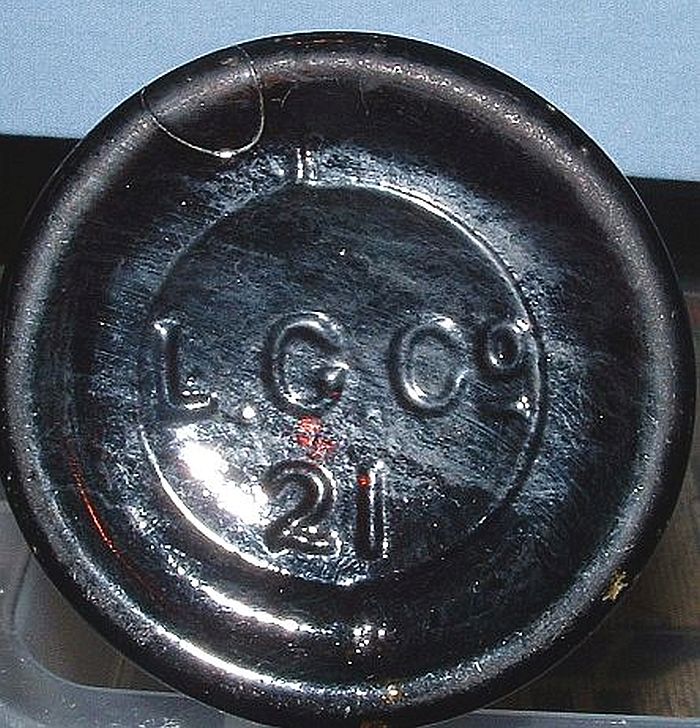
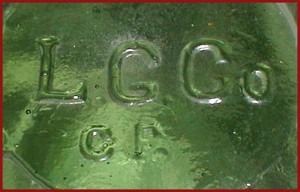
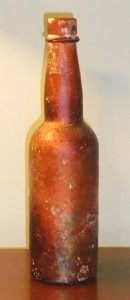
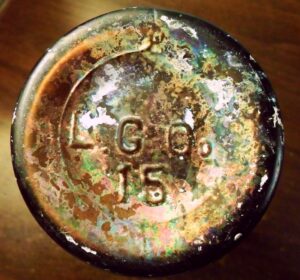

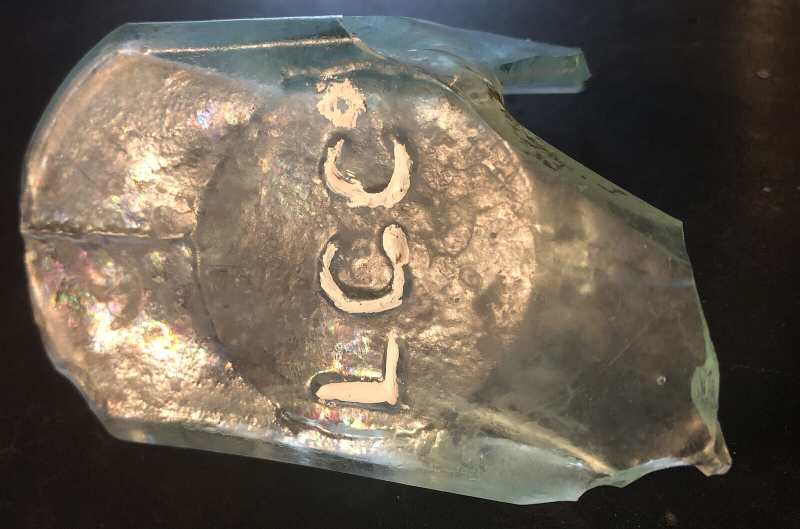
ADVERTISEMENT
2) Lyndeborough Glass Company (often spelled Lyndeboro), South Lyndeborough, New Hampshire (1866-1888), with the mark seen on cylinder whiskey bottles, whiskey flasks and other types of bottles. The “L. G. Co.” lettering on Lyndeborough flasks is usually arranged in a circular formation (in the center of the base – on pint size flasks), OR with the “L.G.” and the “CO.” placed at opposite ends of the base with the circular, concave mold seam “disc” or large “button” between them. Most Lyndeboro-produced flasks are found in the Northeastern states of the US, especially NH, VT and ME. The picture here shows the base of a cylinder whiskey-type bottle. (Photo of example posted on ebay).
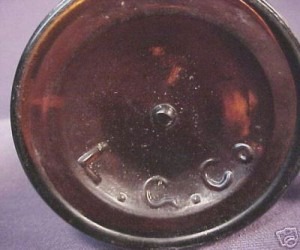

Also, concerning later period machine-made bottles in clear glass:
3) Lamb Glass Company, Mt. Vernon, Ohio (c.1920-1964?) can now be confirmed as the source of milk bottles marked “L G CO / 52” (See “L-52” entry on page three). These appear to be from the 1920s-1940s period. Lamb Glass also (to a much lesser extent) made some other types of jars including “packer ware” product jars, typically for food items sold in retail stores.
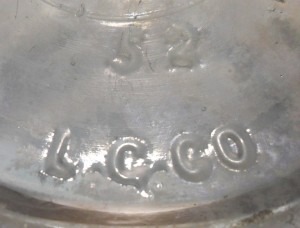
Jeffrey Giarde, in his comprehensive reference book on milk bottles, stated that this mark was likely that of Liberty Glass Company, Sapulpa, Oklahoma, but I believe that to be incorrect.
Another factory that has been confirmed to be the source of some, if not many, milk bottles marked “L.G.CO.” was….
4) Lockport Glass Company, Lockport, New York (1900-1919). An extant catalog proves this to be true. The initials are often accompanied by a single digit number, such as a “1”.
LOOGOOTEE GLASS COMPANY
William Brantley, in A Collector’s Guide to Ball Jars (1975), page 25, stated that Loogootee Fruit Jar Company, Loogootee, Indiana (1901-1904) produced wax sealer jars with the “L.G.CO.” base mark. The actual name of that glass company was, in fact, Loogootee Glass Company, so it seems possible that COULD be true, but I know of no real evidence to support his assertion. (If you have any information that might help shed light on this question, please write!) My own opinion is that all L.G.CO.-marked wax sealer jars are products of Lindell. Other wax sealers with a nearly identical profile (a slightly more angular shoulder and a taller neck area) are found which are marked “LINDELL GLASS CO.” on the base.
“L G Co” Monogram, as seen on the front of certain “MASON’S PATENT NOV 30TH 1858” style fruit jars
This monogram, which is generally accepted as the letters “L G Co” (although some collectors are not so sure), appears on the front of a certain variant of the very common “Nov 30th 1858” type jars. (Looking at them as a group, the 1858 jars were made in huge numbers by many, many glass companies from 1858 to about 1912). This particular jar variant is catalogued as “#1970” in the Red Book price guide listings used by collectors. The drawing here, by Howard Creswick, appears in The Fruit Jar Works (Alice Creswick) as well as in accompanying issues of the Red Book (now published by Douglas Leybourne, Jr).
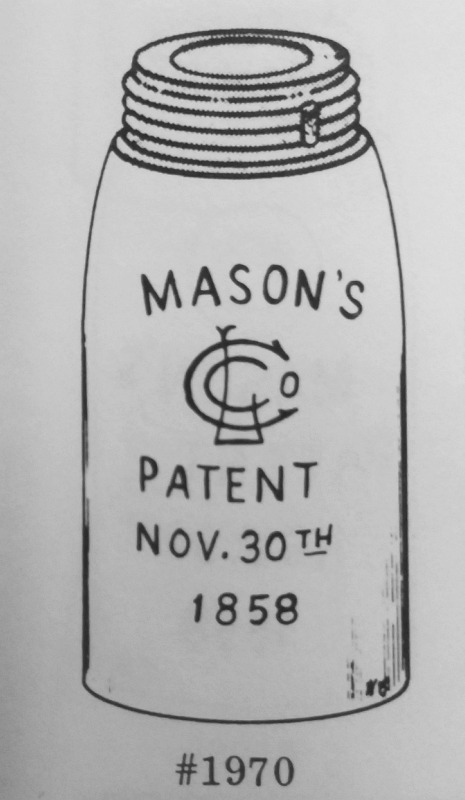
No one has proven what the “L G Co” monogram in this case represents, but the jars tend to show up most often in the Midwestern US, especially in Illinois, Indiana, Iowa, Missouri, Ohio, Kentucky, Michigan and Wisconsin. The most likely candidate for the meaning of the monogram is Lindell Glass Company of St. Louis. However, this is not an attribution that can be said to be 100% certain, as absolute proof is still lacking!
Julian Toulouse, in his reference Bottle Makers and their Marks (1971) includes a drawing of this monogram on page 323 of the book, and attributes it to Louisville Glass Works (Louisville KY Glass Works). Although it is possible, I doubt that this attribution is correct, as that particular company was never known as “Louisville Glass Company” – so the initials don’t match.
A very similar jar, which is found occasionally, seems to show that the molds used for the LGCo monogram jars were, at some time, retooled to turn the monogram into “I G Co”. This was first noted by researcher Dick Roller, and is mentioned in this article on various “L” marks by Bill Lockhart et al: https://sha.org/bottle/pdffiles/LOther.pdf
That observation seems to show the molds were sold to a company with the initials “I G CO” which points to (most likely) Illinois Glass Company of Alton, Illinois. Since Lindell Glass Company was right across the Mississippi River from Alton, this is another clue that points to Lindell as the most likely candidate for the maker of the LGCo monogram jars.
Please click here to return to the Glass Bottle Marks pages, page 3. Several other similar or related marks are listed there, including “L G W”, L-52 and L-G.
Click here for my website HOME PAGE.
ADVERTISEMENT

